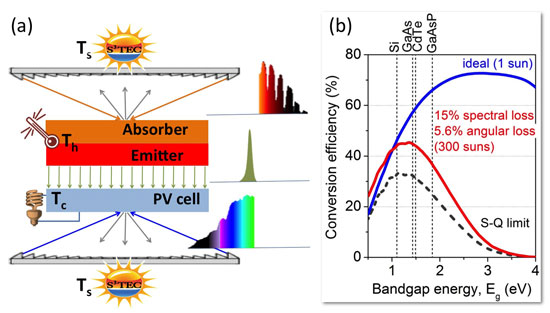| Posted: Dec 05, 2013 | |
Increasing solar cell efficiency limit by 'heating up' 'cold' photons |
|
| (Nanowerk Spotlight) The quest for efficient low-cost solutions for solar energy conversion faces many obstacles, both, fundamental and technical. Fundamental limitations to the maximum achievable efficiency of solar cells stem from a combination of several factors. These include: 1) solar cells inability to use photons with the energies below the electronic bandgap of their material; 2) thermalization of charge carriers generated by absorption of the photons with above-bandgap energies; and 3) the losses caused by recombination of the light-generated charge carriers. | |
| As a result, even ‘ideal’ solar cells have maximum intrinsic efficiency – known as the Shockley-Queisser (S-Q) limit – of 33% for the illumination by the non-concentrated sunlight. | |
| A number of architectures have been proposed for reducing losses in solar cells in order to overcome the S-Q single-junction limit. These include hot carrier solar cells, intermediate band solar cells, up- and down-converters, and concentrators, as well as cells with nanostructured materials that utilize multiple-exciton generation, exciton fission, and tandem stacking (read more: "Practical roadmap and efficiency limits to nanotechnology photovoltaics"). | |
| "The S-Q limit can be exceeded by utilizing low-energy photons either via their electronic up-conversion or via thermophotovoltaic (TPV) conversion process," Dr. Svetlana V. Boriskina, a research scientist in the Mechanical Engineering Department at Massachusetts Institute of Technology (MIT), explains to Nanowerk. "However, electronic up-conversion systems have extremely low efficiencies, and practical temperature considerations limit the operation of thermophotovoltaic converters to the low-quality narrow-gap solar cells." | |
| In new work, Boriskina together with Gang Chen, Carl Richard Soderberg Professor of Power Engineering and Director, Pappalardo Micro and Nano Engineering Laboratories, at MIT, have proposed a new way to break the fundamental S-Q limit by using a mechanism of thermal up-conversion. | |
| Reporting their results in Optics Communication ("Exceeding the solar cell Shockley–Queisser limit via thermal up-conversion of low-energy photons"), the two MIT researchers, who also participate in the DOE-funded Solid State Solar-Thermal Energy Conversion Center (S3TEC), show that solar-to-electricity conversion efficiency higher than the S-Q limit can be achieved in a hybrid platform that combines a single-junction solar cell and a thermal up-converter. | |
 |
|
| Thermal up-conversion concept (a) and maximum achievable efficiency as a function of the solar cell bandgap (b). (Image: Svetlana V. Boriskina, MIT). (click image to enlarge) | |
| "Within our proposed hybrid scheme, photons with energies below the bandgap of the solar cell are absorbed by the up-converter, which heats up and re-emits photons with higher energies towards the solar cell," says Boriskina. "To make this process possible, both front and back surfaces of the up-converter must have carefully designed angular- and frequency-selective emittance characteristics." | |
| While this work – via rigorous thermodynamic analysis – provides theoretical estimates of the maximum intrinsic efficiency limits of the solar energy conversion in a hybrid system with thermal upconversion, recent advances in nanofabrication technologies put the fabrication of selective surfaces within reach. There are on-going research efforts with various approaches like photonic crystals, nano-cones, domes and pyramids, quasi-periodic planar arrays, and plasmonic metamaterials, to accomplish angular and spectral selectivities simultaneously by the absorber surface design. | |
| Boriskina and Chen predict that the maximum efficiency of a hybrid device utilizing the thermal up-conversion scheme can reach 73% for the ideal spectrally- and angularly-selective emittance characteristics of the up-converter surfaces under illumination by the non-concentrated sunlight. | |
| "Reaching high up-conversion efficiency requires raising the up-converter temperature, which for the commonly used photovoltaic materials – e.g., Si, GaAs, CdTe, and GaAsP – lies within practically achievable 900-1600K range," notes Boriskina. "Detailed analysis of non-ideal up-converter surfaces that allows for reasonable absorption and emission losses still yields limiting efficiency values exceeding 45% for moderate optical concentration of 300 suns." | |
| The bottom line is that the proposed hybrid platform offers new opportunities for reaching high solar energy conversion efficiency under low levels of optical concentration achievable via simple low-cost technological solutions. | |
 By
Michael
Berger
– Michael is author of three books by the Royal Society of Chemistry:
Nano-Society: Pushing the Boundaries of Technology,
Nanotechnology: The Future is Tiny, and
Nanoengineering: The Skills and Tools Making Technology Invisible
Copyright ©
Nanowerk LLC
By
Michael
Berger
– Michael is author of three books by the Royal Society of Chemistry:
Nano-Society: Pushing the Boundaries of Technology,
Nanotechnology: The Future is Tiny, and
Nanoengineering: The Skills and Tools Making Technology Invisible
Copyright ©
Nanowerk LLC
|
|
|
Become a Spotlight guest author! Join our large and growing group of guest contributors. Have you just published a scientific paper or have other exciting developments to share with the nanotechnology community? Here is how to publish on nanowerk.com. |
|
